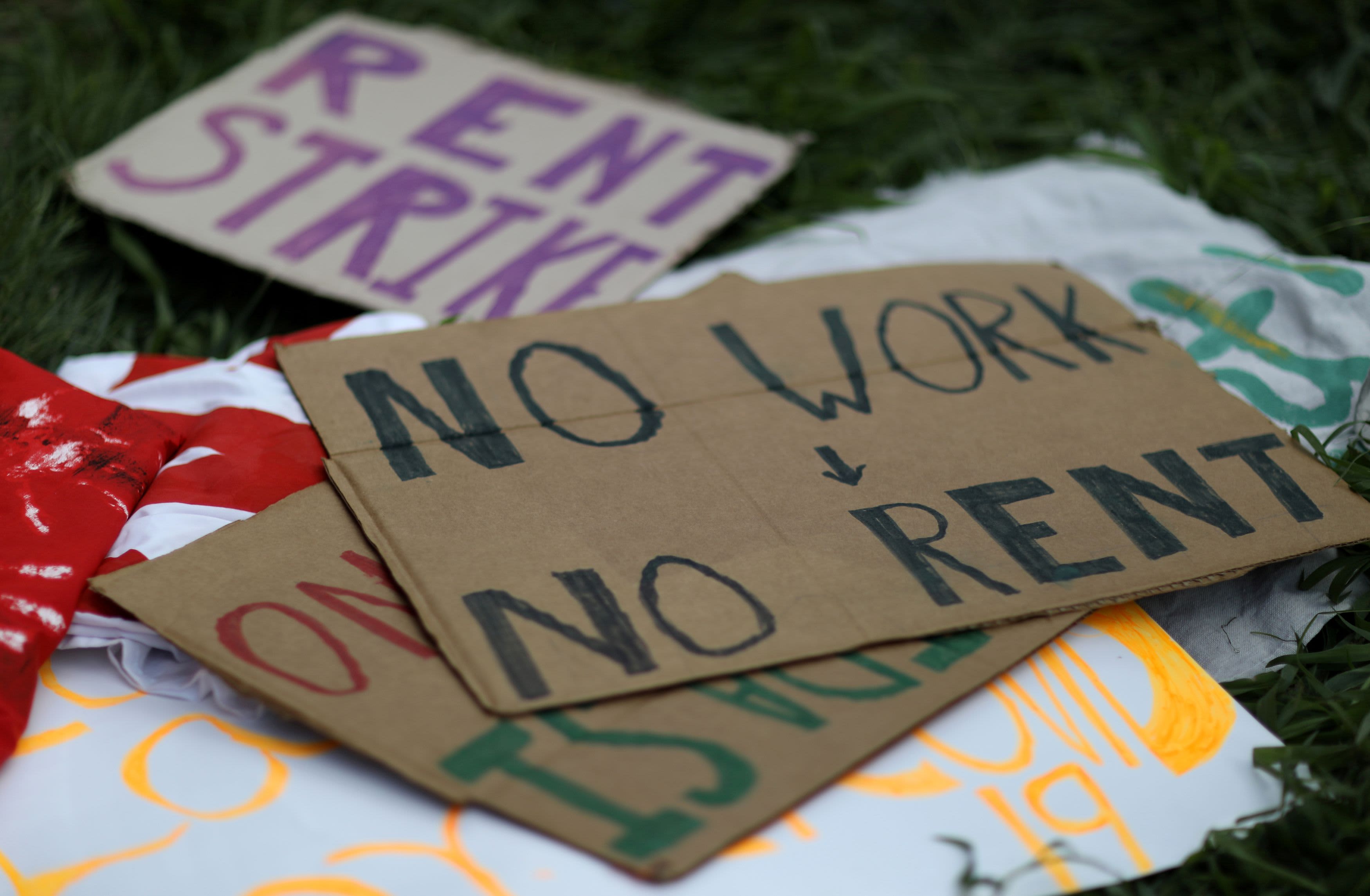
Handmade signs litter the ground after an anti-eviction protest outside a Mount Rainier, Maryland, apartment complex on Aug. 10, 2020.
Leah Millis | Reuters
Even with the latest coronavirus relief bill, the economic stresses from the pandemic will continue to mount. An assortment of federal, state, and local foreclosure, eviction, and debt collection moratoria have kept creditors at bay, and unemployment insurance has helped many families to stay afloat.
But neither the collection moratoria nor unemployment insurance will last forever, and they are likely to lapse as Covid-19 wanes. That’s when the bill will come due.
Collection moratoria merely stop collection actions; they do not cancel debts. Unemployment insurance typically replaces only a fraction of consumers’ income, so bills mount up when a consumer is out of a job. When the moratoria lapse, consumers will still owe months of back rent or mortgage payments, not to mention interest and late fees that have been accruing.
Those debts will not go away as the economy picks up. Many families were just getting by before Covid. They have no financial safety net, and little if any ability to catch up on overdue bills from their future earnings. And for some families, there will not only be the usual bills, but also crushing medical bills related to Covid.
The scope of the problem is hard to quantify, but there is no question that it is enormous. When collection moratoria end, there will be a tsunami of foreclosures, evictions, and collection actions.
Bankruptcy has long been the economy’s safety valve for financial distress. When consumers get overloaded with debt, bankruptcy gives them the possibility of a fresh start and serves as a type of social insurance by spreading losses among creditors. Unfortunately, however, the bankruptcy system poses too many obstacles to consumers getting the immediate relief they need.
The scope of the problem is hard to quantify, but there is no question that it is enormous. When collection moratoria end, there will be a tsunami of foreclosures, evictions, and collection actions.
Under current bankruptcy law a consumer can choose between filing for chapter 7 bankruptcy or chapter 13 bankruptcy. In chapter 7, the consumer surrenders her assets (other than certain minimal necessities), but retains all future income, and gets an immediate “discharge” of her debts.
In chapter 13, the consumer retains her assets, but commits to a repayment plan under which creditors get all of her disposable income for the next three to five years. In chapter 13, the consumer only gets a discharge upon completion of the repayment plan, something most debtors fail to achieve. These consumers who fail to complete their plans have lived under onerous conditions during the duration of the plan, with little to show for it.
Higher income consumers are required to file for chapter 13, but many lower income consumers do so to out of necessity: there is no provision for payment of the consumer’s lawyer in chapter 7, so unless the debtor can “save up to file for bankruptcy,” the only choice to pay the lawyer is as part of a chapter 13 repayment plan, and chapter 13 attorneys’ fees are more than double that of chapter 7. In other words, because consumer bankrupts are broke, they are forced to file for a type of bankruptcy that is too complex and expensive for their needs and often fails to provide them with any actual debt relief.
Paying for a lawyer is just the beginning, however. Current bankruptcy law is obsessed with catching the conniving debtor who is using bankruptcy to get out of debts that he can afford to pay. Yet, this sort of abuse is rare as bankruptcy is not a free ride.
Honest and unfortunate debtors—like Americans whose financial lives have been destroyed by Covid — have to file reams of unnecessary paperwork even it is apparent their bankruptcy cases are meritorious. These requirements drive up the cost of filing for bankruptcy and function as trips and traps that can prevent even deserving debtors from getting the relief they need.
What’s more, even when consumers are able to get their debts discharged in bankruptcy, there are exceptions to the discharge. Most notably, student loan debt is generally nondischargeable. Additionally, if a debtor wants to keep his home or car in bankruptcy, the debtor must pay off the loan according to its original terms. It’s of no matter that the car or house might be worth only a fraction of the amount owed on the loan.
Nor do renters fare any better. If a renter wants to stay in her lease, bankruptcy law requires that she immediately catch up on all back rent. This is a hopeless proposition for most debtors; if the debtor had the money, she would not be behind on the rent in the first place.
New legislation can reform the system
Recently introduced legislation cosponsored by Sen. Elizabeth Warren, D-Mass. — the country’s leading consumer bankruptcy law expert in her former job as a law professor — would correct these shortcomings with a wholesale reform of the consumer bankruptcy system.
I was happy to advise and help with the bill as it was drafted because the reform is so needed. The proposed legislation would give consumers the tools to address all of their financial obligations — mortgages, car loans, student loans, medical debt, and more. It would enable renters to stay in their leases without catching up on months of back rent. And it would make it possible for consumers to actually afford to file for bankruptcy.
Collection moratoria have bought Congress some time to act before the debt collection tsunami strikes. Congress should take action to reform consumer bankruptcy law so that it can operate as an effective safety valve for consumers’ economic fallout from Covid.
Adam J. Levitin is a law professor at Georgetown University.



